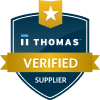Fluorosilicone vs. Silicone for O-rings, Gaskets, Tubing and Seals
Fluorosilicone rubber (FVMQ) is a variation of silicone featuring stability, compression set resistance to temperature extremes, and enhanced resistances to non-polar solvents, fuels, oils, acids, and alkaline chemicals. This material is common in many industrial, automotive, and aerospace applications where static sealing and cushioning is required.
FVMQ contains trifluoropropyl groups, making it highly versatile for outdoor sealing applications or environments where exposure to sunlight, ozone, chlorination, or aromatic hydrocarbons is common. The basic properties of fluorosilicone include:
- Temperature range: -60–200º C
- Compression set: Fair/good
- Strength: Fair
- Low temperature properties: Excellent
- Abrasion resistance: Poor
- Gas permeability: Fair
- Weather resistance: Excellent
- Water resistance: Excellent
- Ozone resistance: Excellent
- Mineral oil resistance: Excellent
- Chemical resistance: Excellent
- Flame resistance: Excellent
- Heat resistance: Excellent
A comparison between fluorosilicone and silicone in relation to their use in O-rings, gaskets, tubing and seals allow users to choose the best solution for specific applications.
Fluorosilicone vs. Silicone
Silicone elastomers—also known as silicone rubbers—are composed of silicone, carbon, hydrogen, and oxygen. They are non-reactive, stable, and resistant to extreme environments and temperatures from −55–300° C (−67–572° F). They share these characteristics with fluorosilicones.
Fluorosilicone rubber distinguishes itself from silicone because it also contains additional beneficial properties common to fluorocarbons. The addition of these compounds enhances FVMQ’s capacity to resist solvents, fuel, and oil. Fluorosilicone has a slightly lower maximum service temperature hot air resistance than silicone.
Fluorosilicone O-rings, Gaskets Tubing and Seals
Fluorosilicone’s distinctive properties make it ideal for use in the sealing solutions found in engines, machines, and other mechanical systems. Common fluorosilicone sealing components include:
- O-rings. Shaped like a donut, O-rings are usually seated within a groove on one or both of the joined parts where they form a seal, where they block the escape of air and fluids by filling in the space between coupled components.
- Gaskets. Gaskets provide a flexible seal between two joined components. They are usually flat and relatively thin, with bolt or pin penetrations through them. Compressed between two flat surfaces, gaskets provide sealing as well as vibration control.
- Seals. This is a general term for any component that prevents fluid/air leakage fluids, blocks contaminants, or maintains pressure. O-rings and gaskets are types of seals, but the term usually applies to application-specific sealing solutions held in place by compression, such as oil seals found in engines.
- Tubing.
O-rings, gaskets and seals fill the space between two joined parts in a machine or engine, allowing for the conveyance or transfer of fluids or air between them without leakage. Beyond fluid and vapor leakage, these components prevent debris from entering into mechanical systems and maintain consistent pressures to ensure optimal performance.
Recommended Uses of Fluorosilicone O-rings, Gaskets Tubing, and Seals
Certain systems, environments, and applications benefit from the use of O-rings, gaskets, tubing, and seals created with fluorosilicone, including:
- Jet fuel systems
- Dry heat environments
- Broad temperature range environments
- Some petroleum oil applications
- Chlorinated solvents environments
Non-Recommended Uses Fluorosilicone O-rings, Gaskets Tubing and Seals
Though their properties provide ideal solutions in the above instances, there are other applications where the use of fluorosilicone O-rings, gaskets, tubing, and seals will produce less desirable or negative results, including applications containing:
- Ketones (MEK)
- Phosphate esters
- Some acids
- Auto/aircraft brake fluids
- Amines (ammonia)
Benefits of Fluorosilicone O-rings, Gaskets, Tubing and Seals
There are certain special features provided by fluorosilicone O-rings, gaskets, and seals. Seals made of FVMQ provide benefits such as:
- Excellent flexibility and compression set resistance
- High-level aging, weather, and UV resistance
- Resistance to animal and vegetable oils, fuels, oxidizing chemicals, aromatic and chlorinated solvents
- Capacity to withstand aliphatic and aromatic fluorocarbons, diluted alkalis, toluene, benzene, ozone, diester oils, silicone oils, and oxidative environments
Fluorosilicone Sealing and Tubing Solutions from Vanguard Products
The specialized properties of fluorosilicone provide many of the benefits of silicone while adding additional resistances to non-polar solvents, fuels, oils, acids, and alkaline chemicals. These benefits make it the right solution for the formation of O-rings, gaskets, tubing, and seals used in many industrial, automotive, aerospace and aviation applications.
Vanguard Products Corporation is a provider of fluorosilicone O-rings, gaskets, tubing, and seals for these and other applications. Contact us to learn more about the fluorosilicone sealing solutions available from Vanguard.











